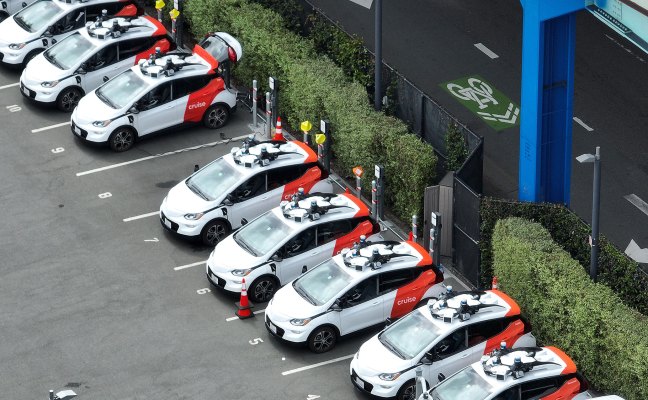Cruise keeps getting kicked while it’s down. The General Motors-owned robotaxi company may face fines and sanctions after failing to disclose details of an October 2 incident — specifically that one of its vehicles dragged a pedestrian 20 feet, according to a ruling from a California agency.
The regulatory action comes as Cruise struggles to rebuild public trust and keep operations running after losing its permits to operate in California for allegedly withholding crucial information from regulators about a crash in San Francisco.
Over the past two months, Cruise paused all driverless and manual driving operations across the U.S., has implemented a safety review of its robotaxis and tapped a law firm to examine its response to the incident. The company recalled its entire fleet and halted production on its Origin robotaxi. Its co-founder and CEO Kyle Vogt stepped down, alongside chief product officer Daniel Kan.
The California Public Utilities Commission (CPUC) on Friday ordered Cruise to appear at a February 6 hearing to defend itself against accusations that it failed to provide “complete information to the Commission” regarding the incident, and “for making misleading public comments regarding its interactions with the Commission.”
On the evening of October 2, a human driver struck a pedestrian in San Francisco, the impact of which caused the pedestrian to fall in a Cruise robotaxi’s path. The AV instituted a hard-braking maneuver and came to a stop, but ended up running over the pedestrian in the process.
The CPUC — and the California Department of Motor Vehicles — says that order of events was shared with the agency. Cruise allegedly left out what came next. The Cruise AV attempted a pullover maneuver while the pedestrian was still stuck under the vehicle, resulting in them being dragged.
Per the CPUC’s ruling:
On October 3, 2023, Jose Alvarado of Cruise telephoned Ashlyn Kong, a CPED analyst at the Commission, and informed her of the collision. During this telephonic meeting, Mr. Alvarado’s description of the incident only included that the Cruise AV immediately stopped upon impact with the pedestrian and contacted Cruise’s remote assistance. Mr. Alvarado’s description of the October 2, 2023 incident omitted that the Cruise AV had engaged in the pullover maneuver which resulted in the pedestrian being dragged an additional 20 feet at 7 mph.
Over the next couple of weeks, the CPUC and the DMV issued data requests seeking more information of the incident, including video documentation. According to the CPUC, it took Cruise up to October 19, or a full 15 days, to provide the agency with the full video of the incident.
After the incident, Cruise published a blog post, which it has since taken down, detailing the events. The company wrote in the post that it had “proactively shared information…including the full video” with various regulators, including the DMV, CPUC and the National Highway Traffic Safety Administration. Kong in a statement said that Cruise’s blog post was “inaccurate.”
“The full video was shared only in response to a data request more than two weeks after the incident,” she said.
The commission’s ruling didn’t include a specific penalty, but the agency can fine a public utility between $500 and $100,000 per day there is a violation, in addition to other penalties. That means Cruise could be looking at maximum $2.25 million in fines, given the amount of time it took the company to turn over a full video of the event.
The CPUC has already suspended Cruise’s permits to charge for passenger robotaxi rides in California, and it is considering the city of San Francisco’s request to redo the August hearing that granted Cruise a permit to charge in the first place. Alphabet-owned Waymo also received a similar permit at the same time, despite strong opposition from city stakeholders. So far, Waymo has mostly managed to stay out of the public ire, but Cruise’s woes affect the industry at large.
GM has until December 18 to hand-deliver a “verified statement,” which will include “all facts, arguments and legal authorities that support Cruise’s position,” to Administrative Law Judge Robert M. Mason III, “along with a three-ringed binder containing a copy of all authorities cited in the verified statement.”
Cruise told TechCrunch it is committed to rebuilding trust with regulators and will respond in a timely manner to the CPUC. GM is working with law firm Quinn Emanuel to examine Cruise’s response to the October 2 incident, including the company’s interactions with law enforcement, regulators and the media. Cruise also showed TechCrunch a shortened version of the video in early October.
A spokesperson from the company said the outside review should help Cruise strengthen its protocols and improve its response to these types of incidents in the future.
It’ll take time for Cruise to get back to where it was before this incident. GM had told investors that Cruise was on track to generate $50 billion in revenue per year by 2030. The company was expanding at a rapid clip, announcing new test and launch cities seemingly every week. Aside from San Francisco, Cruise had been charging for driverless rides in Austin, Houston and Phoenix, and had quietly launched driverless testing vehicles in Miami right before it lost its permits in California.
Cruise said last month that it plans to eventually relaunch in one city, but didn’t provide a timeline. The company is also reviewing layoff plans.
Last week, GM CEO Mary Barra said the automaker will slash spending on the unit next year by “hundreds of millions.” Cruise has lost more than $8 billion since 2017, including $732 million in the third quarter of 2023.
